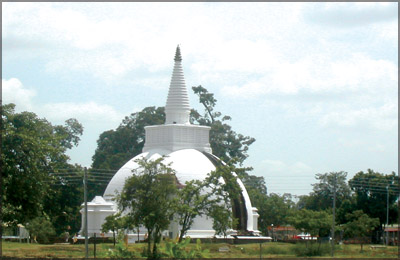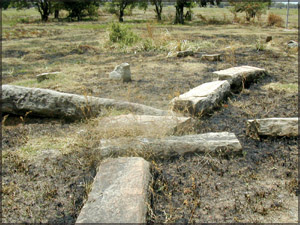|
Somawathie Chetiya:
Enshrines the Buddha's Tooth Relic
 The
Somawathie Chetiya, which is situated about 40 kilometres from
Polonnaruwa, is once again attracting pilgrims from throughout the
island. This venerated Buddhist site is said to enshrine the right
canine Tooth Relic of the Buddha. The
Somawathie Chetiya, which is situated about 40 kilometres from
Polonnaruwa, is once again attracting pilgrims from throughout the
island. This venerated Buddhist site is said to enshrine the right
canine Tooth Relic of the Buddha.
Ancient chronicles of Sri Lanka state that the very first Arahat of
this country, Aritta Thera, visited the residence of Gods and brought
back to Sri Lanka the Sacred Right Tooth of the Buddha.
It is believed to have been built long before the time of Dutugemunu
and as such, is much older than the Ruwanweliseya, Mirisawetiya or
Jetawanaramaya. It is believed to have been built during the reign of
King Kavantissa - Dutugemunu's father who ruled Magama.
Legend has it that Kavantissa's sister Somawathie Devi, married to a
prince named Abhaya, built a dragoman for her husband in her name, in the second century BC. According to the
Mahawamsa, the royal couple left Ruhuna and sought refuge in Raja Rata
over a disagreement with King Dutugemunu who was also the nephew of
Somawathie.
for her husband in her name, in the second century BC. According to the
Mahawamsa, the royal couple left Ruhuna and sought refuge in Raja Rata
over a disagreement with King Dutugemunu who was also the nephew of
Somawathie.
Queen Somawathie had a yearning to construct a stupa in honour of the
Buddha. The King himself agreed to this idea with much enthusiasm.
Giri Abhaya had explored a possible site to construct this stupa. In
the course of his survey, he came upon an area where Bhikkhus led by
Arahat Mahinda resided. When the King suggested his idea to Arahat
Mahinda, he gave his consent to the stupa-building project.
This location was known as Somapura. There were companion stupas
named Kumbanacchaduwa (identified as the place where the Kadol elephant
had died), Gal Amuna, Sangabodhigama and Vihara Surangala.
The pilgrim to this holy shrine today can see on one side of the
dagoba, a trench-like opening revealing some five feet inside the
present dagoba, wherein is the ancient brick masonry of the earlier
dagoba.
As such, the present freshly painted white dagoba is an enlargement
of an earlier one. Two kings have renovated the chetiya and visitors can
view the section of the chetiya which reveals the three layers
illustrating the three periods during which renovations were undertaken.
According to scholars, some Brahmin characters found at this site
have been identified with the second century. Seven stone inscriptions
detailing the history of the dagoba have been found in the area.
|

Some ancient pillars that have been destroyed |
Separate inscriptions found here refer to the Rebavehera and Pajini
Naka Araba Vihara, which are presumed to be the ancient names of this
monument. According to the latter, it is believed that this vihara was
constructed by Naka, the son of King Mahallaka Naga in the second
century.
Like the road to Seruwila Dagoba, here too, the journey itself offers
you a variety of thick jungle and swamp as well as their inhabitants,
big and small. In fact, the dagoba is often visited at night by
elephants. Sungawila is the last little town and border village from
where you cross the Mahaveli to travel on some 13 kilometres of unsealed
road that cuts through the Somawathie's strict natural reserve and
wildlife sanctuary, and takes you through the jungle and marshy land to
the great dagoba.
The writer, during a recent visit to this ancient temple, could
witness the scene where the people who cleaned the jungle area had burnt
the garbage on the site of some ancient pillars. There were no
authorities from the Department of Archaeology to take action.
According to Civil Security Officer, W.E.M. Gunarathne, no
restorations had been carried out at the site during the past nine
years, ever since the day he was placed on duty at this site.
The Chief Priest at the temple, Pahamune Sri Sumangala Thera also
confirmed this fact and added, "Actually, no restoration has been
carried out here since 1981. Apparently, there is a shortage of funds."
Because elephants encroach into the temple premises, an electric
fence has been installed there. This fence is powered by solar
electricity. Electricity is switched on in the evening from six onwards.
The Somawathie Chetiya is very famous in recent history due to the
miracles which took place in the temple. Some of the valuable ancient
ruins found from this place have been kept at the Polonnaruwa Museum.
by Janani Amarasekara |
